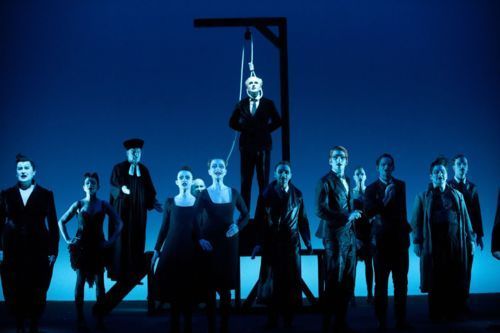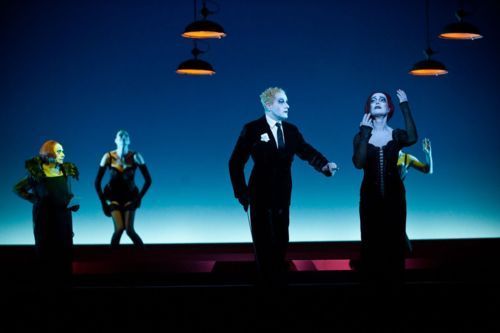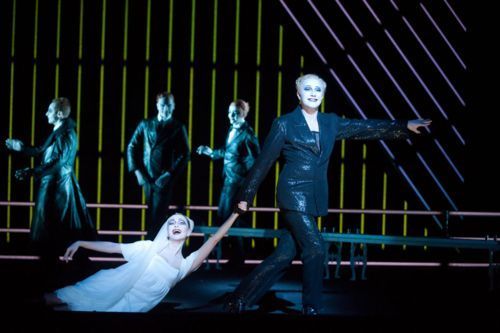THE THREEPENNY OPERA
The Berliner Ensemble appeared at BAM’s Next Wave Festival in its 2009 rendition of “Dei Dreigroschenoper” with direction, stage setting, and light concept by Robert Wilson. It’s another of Wilson’s masterpieces of style and visual mastery. Architect and painter turned director of spectacle, Wilson turns the stage into a canvas for his singular, painterly visions of operas and other works, some of his own creation like his seminal 1976 collaboration with Philip Glass and Andy DeGroat, “Einstein on the Beach,” which is due for yet another revival in 2012.
“The Threepenny Opera,” the German classic written by Bertolt Brecht and composer Kurt Weill remains as politically relevant now as when it premiered in 1928 with its depiction of criminality, in a society of unbalanced wealth distribution, corruption, and police complicity with the criminality. And as the denouement of the play cynically suggests, no matter how bad things look for the hero, some deus ex machina will swoop down and save the day at the last minute. In this case, it’s in the form of a royal decree, giving Macheath a reprieve from the gallows in celebration of the queen’s coronation.

The Berliner Ensemble in Robert Wilson’s production of “The Threepenny Opera”
Macheath, played with arrant androgyny by Stefan Kurt, is a gangster with insatiable sexual appetites and two wives, Polly Peachum (Stefanie Steppenbeck) – daughter of his boss Jonathan Jeremiah Peachum (Jurgen Holtz), the head of a gang of beggars – and Lucy (Anna Graenzer) – daughter of his protector Tiger Brown (Axwl Werner), London’s police chief. Wilson sets the scene with a parade across the stage apron of the all characters, brilliantly costumed by Jacques Reynaud to look like 18th century Englishman William Hogarth’s caricatures. The performers faces are painted white with exaggerated features.
Wilson’s extraordinary stage pictures are like three-dimensional paintings. One might say paintings come to life, but there’s the problem: there’s virtually no theatrical action in the piece; it’s a series of intriguing tableaus that would be appropriate for a coffee-table book, which you could pick up and put down at will. At BAM, you’re stuck in a cramped seat for three hours, forced to watch the pages turn at Wilson’s deliberate pace until the end of the tome.

Angela Winkler, Stephan Kurt
The brothel, for example, is visually ravishing, with nine pool hall lamps overhead that glow pink, as red curbs on the ground rise, tightening the frame, and then separate into horizontal stripes across the space with Macheath’s ladies of the evening popping up at various levels between them like paper doll cutouts.

Stefan Kurt, Angela Winkler
Fluorescent tubes that run vertically, horizontally, and diagonally to form the interior backdrops in several scenes, create a stroboscopic effect, when people in silhouette crossing in front of them.

Stefanie Stappenbeck, Stefan Kurt
The members of the Berliner Ensemble do their best to transcend the rigor of the staging, especially gender-bending Kurt, golden-throated Winkler, vivacious, full-voiced Steppenbeck, and Jurgen Kurtz and Traute Hoess as Macheath’s in-laws the Peachums. The picaresque bandits and prostitutes come in a rich assortment of shapes, sizes, and breadths of characterization.
Wilson’s first act – which runs Brecht’s first two acts together – lasts for two hours, and after ninety minutes, rear end cramping, nature calling, your concentration turns to the intermission, which can’t come soon enough. The brief second act – 40 minutes – when the plot thickens and dramatic tension should build, is just more of the same handsome stasis. The density of the tableaus increases with more people onstage, but the dramatic tension remains locked in the intellect. It doesn’t help that reading German-to-English supertitles splits our focus and exhausts our vision.
As a visual artist, Wilson’s talent is undeniable, but as a theater director, he’s still a visual artist. Theater demands kinetic as well as visual and dramaturgical artistry. Stylization is a fine place to start in rendering Brecht/Weill’s sardonic work, but Wilson files down its satiric teeth to a nub, replacing emotion with eye candy.
All photos by Stephanie Berger
© Gus Solomons jr, 2011